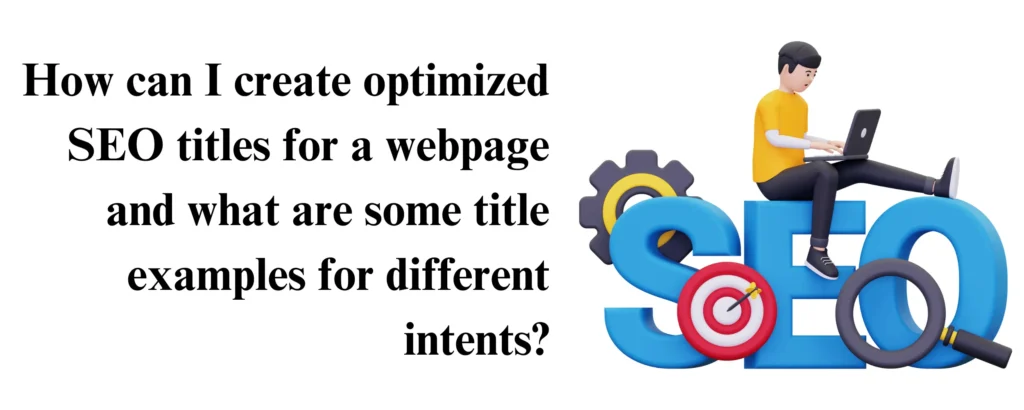SEO Titles That Work: How to Write Titles for Every Goal
Crafting powerful SEO titles is the key to getting your pages noticed, clicked, and ranked. Whether you’re writing for informational content, product pages, or landing pages, the right title can make or break your success.
In this blog post, we’ll break down how to write effective SEO titles tailored to different goals and search intents — with real examples and actionable tips to boost your visibility and engagement.
Introduction: Why SEO Titles Matter More Than Ever
Your SEO title is the first thing people see on search engines—and your only shot at a first impression. A strong, keyword-rich SEO title can dramatically improve your click-through rate (CTR) and help Google understand what your content is about. But what makes an SEO title “good”?
In this guide, I’ll walk you through practical steps and proven examples I’ve used for my own brand, Kilt Master, showing how to write SEO titles that rank and convert—whether you’re working on product pages, blog posts, or service pages.
Step-by-Step Guide to Writing Winning SEO Titles
1. Use Primary Keywords First
Placing your focus keyword at the beginning of the SEO title helps both search engines and users understand your topic instantly. It also increases visibility on mobile devices, where screen space is limited.
Good:
Kilts for Men – Shop the Best Men’s Kilts Online
Bad:
Buy Amazing Kilts – Kilts for Men Online
Avoid repetitive keywords. Instead, use keyword variations and semantically related phrases to build context without stuffing.
2. Keep It Concise (50–60 Characters)
Google typically displays only the first 50–60 characters of an SEO title in search results. If your title is too long, it may get truncated, leading to a drop in clicks.
Optimized Example:
Kilts for Men – Shop the Best Men’s Kilts You’ll Ever Love (57 characters)
Pro Tip:
For maximum consistency across devices, keep your SEO titles between 50–54 characters.
3. Highlight Your USP (Unique Selling Proposition)
Your SEO title should reflect what makes your offering different. This improves both relevance and emotional appeal.
My Kilt Master Formula:
- Quality: “Best Men’s Kilts” = Premium craftsmanship
- Emotion: “You’ll Ever Love” = Emotional connection
- Action: “Shop” = Motivates the user to take action
Example SEO Title:
Kilts for Men – Shop the Best Men’s Kilts You’ll Ever Love
4. Use Strong CTAs (Calls to Action)
Including CTAs in your SEO titles boosts engagement by guiding users toward a specific action.
Effective CTA Verbs:
Buy • Shop • Discover • Explore • Learn • Try Now
Example:
Kilts for Men – Shop the Best Men’s Kilts Today
This encourages clicks while clearly reflecting the intent of the page.

5. Comparison Table: Optimized SEO Titles vs. Poor Titles
| Feature | Optimized SEO Title | Poorly Written Title |
|---|---|---|
| Keyword Placement | At the beginning | Buried or missing |
| Title Length | 50–60 characters | Too short or too long |
| CTA | Clear and actionable | Missing or generic |
| USP | Highlights value, benefit, or emotion | No unique point |
| Readability | Clear, well-structured | Keyword-stuffed or awkward |
This table clearly shows the importance of properly structured SEO titles in performance and engagement.
6. Use Clean Separators
Readable SEO titles use separators to distinguish segments of information. These separators improve scanability for both users and bots.
Best Separators to Use:
- Hyphen (–)
- Colon (:)
- Pipe (|)
Examples:
- Kilts for Men – Premium Men’s Kilts Online
- Kilts for Men: Shop Scottish Style
- Kilts for Men | Best Deals on Men’s Kilts
My preferred choice is the hyphen (–) for its balance between readability and style.
Bonus Tip: Avoid emojis or symbols unless you’re targeting a highly informal or niche audience.
7. Avoid Keyword Stuffin
Search engines are smarter than ever. Overusing your keywords can make your SEO titles sound unnatural and spammy, potentially hurting your rankings.
Better Title:
Kilts for Men – Shop the Best Men’s Kilts
Worse Title:
Men’s Kilts, Buy Kilts for Men, Best Kilts Online
Always aim for clarity and relevance, not repetition.
8. Add Your Brand Name (If Space Allows)
If you still have room in your SEO title, consider adding your brand to build authority and increase brand recognition.
Example:
Kilts for Men – Shop the Best Men’s Kilts – Kilt Master
Brand names in titles signal trust, especially in competitive industries.
9. Match the User’s Intent
One of the most overlooked factors in writing great SEO titles is matching the search intent. Are users looking to buy, learn, or find a location? Your title must reflect that.
| User Intent | Example SEO Title |
|---|---|
| E-commerce | Kilts for Men – Buy Authentic Highland Kilts Online |
| Informational | How to Wear a Kilt – A Complete Style Guide |
| Local SEO | Kilts for Men in Canada – Shop Now from Kilt Master |
The more accurately your title mirrors the user’s query, the better your CTR and time on page.
Final Thoughts: How to Write SEO Titles That Rank
Creating high-performing SEO titles isn’t just about inserting keywords — it’s about creating a strong user connection, delivering relevance, and inspiring action.
Here’s your quick checklist:
- Start with your focus keyword
- Stick to 50–60 characters
- Include emotional or value-driven language
- Use action-based CTAs
- Break up phrases with clean separators
- Avoid keyword stuffing
- Align with user search intent
- Include your brand name (if space permits)
Mastering the art of SEO titles helps you stand out in crowded search results, drive more qualified traffic, and ultimately grow your business online.